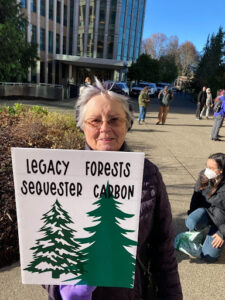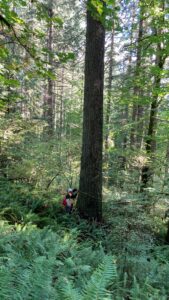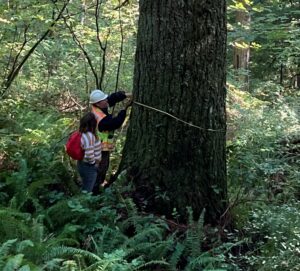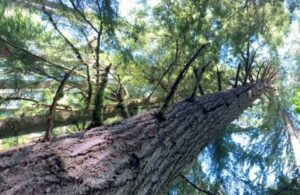Carbon-sequestering superheroes

Almost all of the old growth forests that once populated the south end of Puget Sound have been logged. The South Puget Sound lowlands are now covered mostly by commercial and residential developments, agricultural fields, and industrial forestlands. The few older forests that remain are an important part of our natural heritage.
Keys to a future
They function as ecological “lifeboats” for a wide variety of plant and wildlife species, and lesser-known species of insects, lichens, and fungi. They have been described as “carbon-sequestering superheroes” and “the original teachers of the original people of these lands”—keys to a future in a changed climate, and links to a past not yet erased.
What is a “legacy forest?’
There is a growing movement to abolish the industrial harvesting of these forest landscapes, which in Washington state remain only on public land. A courageous coalition of organizations, including the Center for Responsible Forestry and the Legacy Forest Project, has emerged over the last 18 months to protect these “legacy forests.” Since few people knew what a “legacy forest” was, an early task was to produce a working definition of the term.
A “legacy forest” is “a naturally regenerated (i.e. non-plantation) mixed-species forest selectively harvested before WWII that is now on a healthy trajectory to old growth in dynamic landscapes that are reservoirs of both biodiversity and carbon.”

The most obvious distinction in a legacy forest is that trees are much larger than in managed forests—upwards of 200 feet tall and more than 4 feet in diameter. These forests were often selectively logged or “high-graded” in the early 1900s without benefit of chainsaws. They are much more resilient and more structurally and biologically diverse than the monocrop plantations of Douglas fir preferred by industrial logging companies. These single-species tree farms are prone to disease, drought, and wildfire.
Staying on the path
The Legacy Forest Project has organized several community hikes in Capitol State Forest to locations that the Washington State Department of Natural Resources (DNR) has been preparing for sale. The discovery of a large stand of old growth in the so-called “Smuggler” timber sale in March 2021 was embarrassing.
This egregious error led to a front-page story in the Seattle Times. To her credit, Commissioner of Public Lands Hilary Franz pulled the sale and the 40-acre unit has been spared. Franz announced a pause on the sale of older forests while DNR reviews its older forest policy, but the pause has been inconsistently applied, and legacy forests continue to be sold.
Advocates for legacy forests attend monthly meetings of the Board of Natural Resources and testify at legislative hearings, adding a new and different range of voices to counteract the chorus of those who favor industrial logging.
They want to cut it all
The Board is responsible for approving timber sales proposed by DNR. While legacy forests stand for some as “living landscapes of learning” and “resolute emblems of interdependence and regeneration,” there are powerful interests at work to reduce them to a single financial function.
It is true that rural communities depend on modest revenues from timber sales as well as jobs associated with logging, but given the state’s current financial surplus it should be possible to effect a just transition for those local economies.
It is also the case that public schools in Washington derive a small subset of their funding from the sale of timber on public land. But public school Superintendent Chris Reykdal, who serves on the Board of Natural Resources, has been quoted in the Seattle Times saying “This is not the future of school construction. We just have to think like we are in the 21st century in a climate crisis and not like we are in the 19th century funding schools.”
Lobbyists for the timber industry nevertheless continue to argue that it’s necessary to cut down older forests to keep local sawmills flush with material. However, the trees that are the focus of preservation are so large that few sawmills in the state have the capacity to process them. According to forest advocates, DNR’s Douglas fir plantations hold more than enough timber to satisfy sustainable harvest targets as well as to meet economic demand.
to keep local sawmills flush with material. However, the trees that are the focus of preservation are so large that few sawmills in the state have the capacity to process them. According to forest advocates, DNR’s Douglas fir plantations hold more than enough timber to satisfy sustainable harvest targets as well as to meet economic demand.
It should also be recalled that DNR manages a fraction of the forested landscape in Washington. The vast majority is owned by private corporations like Weyerhaeuser, Green Diamond and Port Blakely, among others. Many of the logs from private lands in our area are shipped overseas through the Port of Olympia.
The “Crush” timber sale in the Capital State Forest
Last fall the Center for Responsible Forestry, the Legacy Forest Project, and a broad array of other organizations initiated a campaign to prevent the DNR from selling legacy trees in the so-called “Crush” timber sale on the north end of Capital Forest.
The sale area includes streams that flow into Kennedy Creek and a majestic forest that surrounds one terminus of the Loki Trail popular among bikers and hikers. The trail is lined with towering old Douglas fir legacy trees, and vast moss-covered old-growth big-leaf maple and cottonwoods.
More than 450 people signed a petition to stop the sale. As part of the campaign, on the morning of the scheduled auction, upwards of 50 people gathered for a spontaneous meeting in front of the Natural Resources Building on the Capitol Campus. In response to speakers outlining the importance of stopping logging of legacy forests on public land, there were shouts of. “DNR has gone too far,” and chants of “Cancel Crush, Cancel Crush.”
Although DNR that morning sold “Crush” to the highest bidder (Cascadia Hardwoods LLC, for $2.6 million), advocates take heart from growing public awareness of the value of preserving legacy forests.
Multiple news outlets featured well-researched stories on the topic in December 2021. In the coming weeks, a Supreme Court decision should help clarify the nature of the “trust mandate” that DNR argues requires them to place profit from timber sales over any other consideration.
An outpouring of public comment at recent monthly Board of Natural Resources meetings caught the attention of Board members. They have started to ask serious questions of DNR staff about the agency’s older forest policy.
Similar coordination of voices speaking on behalf of legacy forests ensured that recent legislative hearings on Hilary Franz’s “Keep Washington Evergreen” initiative did not reflect business-as-usual. One commentator called the proposed legislation “a radical under-achiever bill that borders on greenwashing.” Another introduced a robust amendment that would ensure that the bill includes a core commitment to legacy forests The Center for Responsible Forestry has appealed six recent timber sales and those cases are slowly wending their way through county courts. The Legacy Forest Project continues to organize community hikes in at-risk forests in the Olympia region. As one organizer put it, “2021 was a remarkable year for legacy forests in our region and 2022 is poised to be extraordinary as well.”

Could Legacy Forest Project and Center for Responsible Forestry please provide their contact information, so those interested can join the call for preservation of these important forests, and so we can join in on the hikes?
http://www.wlfdc.org
The Legacy Forests Defense Coalition
Please take a look at the website and make a donation?
Thank you, Janina! Another way to stay in touch with what LFP is doing is through their facebook page: http://www.facebook.com/LegacyForestProject
~ WIP editors